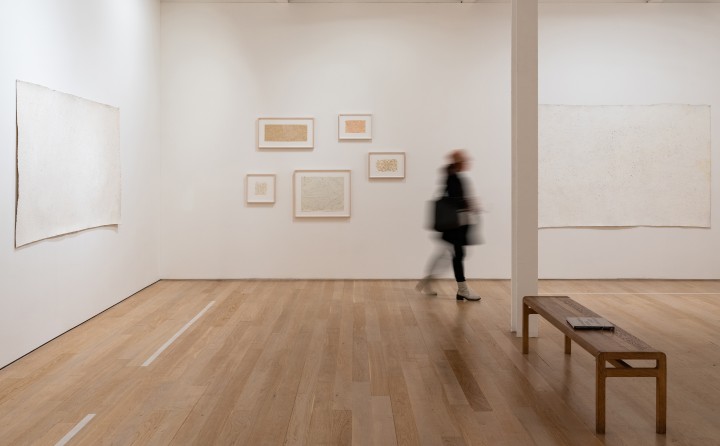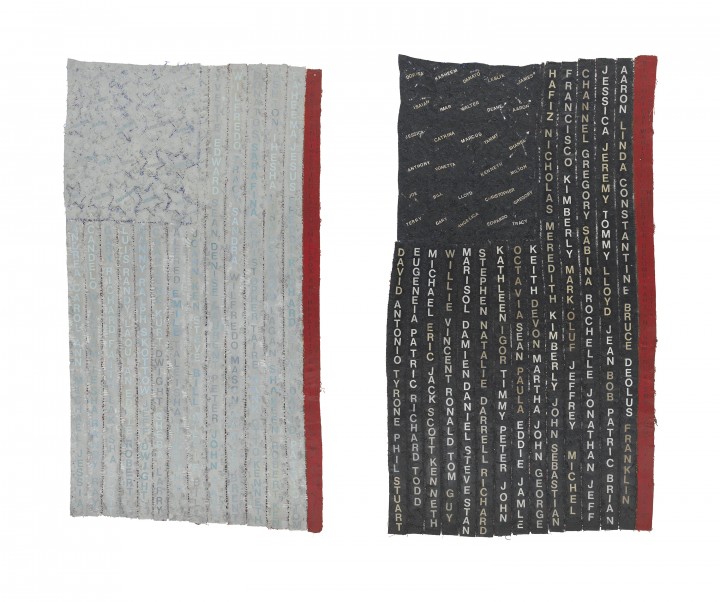Scottish Art News
Latest news
Magazine
News & Press
Publications
Labour and Liberation
By Greg Thomas, 23.11.2021

Howardena Pindell’s work overlays conceptualism and Black activism, forging connections between the two across a series of thrilling and disturbing works. Greg Thomas explores a half-century of creativity at the Fruitmarket, Edinburgh.
In an essay included in the Fruitmarket’s latest exhibition publication Howardena Pindell: A New Language, curator Adeze Wilford recounts a story that the artist found cruelly instructive as a child. The setting is “the Jim Crow South,” which Pindell (b. 1943) was travelling across “on a family road trip. When they stopped at a root beer stand, her father picked up a glass and the artist noticed a large red circle on the base of it. This dot was meant to signal to servers which cutlery and glassware was appropriate for which diners based on race.” Wilford notes how “this other experience burrowed deep with Pindell’s psyche.” Thus, while “the shape has gone on to be something she finds exciting to work with, it is framed by a memory that is linked with cruelty and inequity.”
It’s an apposite image to hold in one’s head while exploring this show, perhaps especially when confronted with the older, lusciously textured works in the ground-floor gallery, which might seem like exercises in serialist escapism infused with a hint of abstract-expressionist soulfulness. A set of large untitled canvases from 1969-72, created by spraying acrylic paint in Fauvist colours through stencils made from hole-punched file dividers, certainly appeal on that level. So too, pieces like 1-6031 with Additions, Corrections and Coffee Stains (1973) find a home amongst the linguistic and numerical exercises of Sol LeWitt and On Kawara. But what sets Pindell’s practice apart from those contemporaries is a worked-over quality and a conspicuous trace of the means and materials of production that suggest – like that title – a deadpan burlesque of administrative labour. This, in turn, connects them to Pindell’s fortunes as an African-American art school graduate in the late 1960s, when she was passed over for 50 straight teaching jobs and was obliged to turn to secretarial roles in the museum sector. Such an experience represents the after-echo of the more overt racism experienced by older generations of her family.
 Howardena Pindell, Parabia Test #4, 1974. Courtesy the artist, Garth Greenan Gallery, and Victoria Miro.
Howardena Pindell, Parabia Test #4, 1974. Courtesy the artist, Garth Greenan Gallery, and Victoria Miro.
This is not to admonish anyone encountering Pindell’s early work as, in the first instance, rhapsodically sensuous, tactile, hypnotic. But hints and clues are furnished throughout that the solipsistic logic of the list or grid is here an oblique marker of sociological and economic realities. Another good example is Parabia Test #3 (1974), a grid-based work formed from the “chads” of paper punched from the stencils used to create other works. These have been exhaustively numbered, but using a Phoenician writing system at the centre of a possibly apocryphal nineteenth-century tale regarding trade contacts between ancient Levantine and South-American civilisations. The script, an ancestor of the Roman Alphabet, had purportedly been used to inscribe a stone tablet detailing the doomed voyage of a Middle-Eastern trading vessel to Brazil during the seventh century BCE, discovered by a slave in the Brazilian state of Paraíba in 1874. A letter outlining the incident, unearthed by a North-American academic in 1966, reignited debates about whether Columbus’s genocidal adventures represented the first Old World contact with the Americas. For Pindell, the incident seemingly spoke to stories of slave labour elided in histories of global society.
The resulting work is a document of both esoteric allusion and mimicked administrative drudgery. Outlined by Anna Lovatt in another catalogue essay, the painstaking process used to create Parabia Test #3 and similar works is almost harrowing to countenance: “[Pindell] used a pair of tweezers, a nail or a needle to hold each chad with one hand while writing with the other, using a fine-tipped Rapidograph pen of the type used in technical drawing. The tweezers could then be used to layer the chads between sheets of graph paper and vellum…arrange them in a grid…or pile them in drifts.” The canvas as record of mental and bodily exhaustion perhaps reflects the conditions of working life for young black women of Pindell’s generation. Elsewhere, the display of a densely cratered stencil (Untitled [Stencil] [1970]) as itself a work of art suggests the artist’s desire to draw attention to the physical and monetary stakes of her creative labour, and perhaps to a domestic economics of thrift writ large for minoritised communities of her era.
 Howardena Pindell, Separate but Equal Genocide: AIDS, 1991–1992. Private collection, Aspen, CO. Courtesy the artist, Garth Greenan Gallery, and Victoria Miro.
Howardena Pindell, Separate but Equal Genocide: AIDS, 1991–1992. Private collection, Aspen, CO. Courtesy the artist, Garth Greenan Gallery, and Victoria Miro.
The political investment of Pindell’s early work is, however, certainly latent and subtle. It’s a visceral shock, then, to encounter the video-work Free, White and 21 in a side-room off the ground floor, a threshold piece preparing viewers for the burning polemical content awaiting them on the first floor. Here, Pindell stitches together various accounts of ostracisation and social and sexual belittlement compiled from incidents across her own and her mother’s life: “after the wedding ceremony…the minister, who was a man in his mid-sixties, came over to me, winked, asked me to dance and then whispered into my ear, ‘I come to New York often, why don’t we get together, we can have some fun’.” The artist performs directly to the camera, interspersing her monologue with shots of herself in white-face as a Caucasian interlocutor, expressing reactions ranging from patronising disbelief to angry disapprobation: “you really must be paranoid. Your art really isn’t political either.” The piece partly reflects Pindell’s frustrations at working with the feminist cooperative gallery A.I.R, which she had cofounded in 1972 to protest gendered discrimination in the art-world, only to discover that for her white, spousally supported co-workers, the ramifications of protest were very different.
Critical accounts of Pindell’s career have tended to draw a line between her ‘conceptual’ and ‘activist’ phases. But importantly, just as downstairs we find sublimated political allegory, upstairs we find a refinement of Pindell’s compositional approach alongside redoubled polemical intent. The 1981 canvas Tarot: Hanged Man is created from a complex aggregation process involving glitter, sutured strips of canvas, and pasted images of human figures and architecture. More recent pieces such as Plankton Lace #1 (2020) take on wavy, cloud-like outlines and bear more deeply reliefed surfaces than her earlier collage work.
That said, what’s most striking about Pindell’s work over the past two to three decades is undoubtedly its decisive turn towards aggregation and list-making as means of detailing racial injustice and violence. Separate but Equal Genocide: AIDS (1991-92) consists of two parallel American flags, one white and one black, inscribed respectively with the names of white and black victims of the HIV virus. Diallo (2000) features 41 white and red dots, each representing a shot fired by NYPD officers at Amadou Diallo, an unarmed black man killed in 1999; the red ones are those which hit. The canvas is inscribed with the names of Diallo and another victim of police violence, Patrick Dorismond, along with a list of words: “racial profiling,” “wallet,” “execution,” murder.” Curvilinear stripes of sans-serif capitals lodge the work partly in a tradition of language-based conceptualism, while appropriating its techniques for ends both contradictory and complimentary to the metaphysical minimalism of, say, Lawrence Wiener. The same compositional motif can be found in the staggering Columbus (2020), which outlines atrocities committed by imperial administrations throughout history and the industrialists who colluded across recent centuries, including the rubber barons who chopped off the hands of restive natives. The canvas is placed above a pile of tar-black severed hands.
 Howardena Pindell, Free, White and 21, 1980 [still]. Courtesy the artist, Garth Greenan Gallery, and Victoria Miro.
Howardena Pindell, Free, White and 21, 1980 [still]. Courtesy the artist, Garth Greenan Gallery, and Victoria Miro.
The crowning achievement of Pindell’s recent creative phase is perhaps her 2020 video work Rope/Fire/Water. Here, serialist impulse is transferred from the visual to the temporal plane, a metronome ticking beneath a voice-over listing the atrocities committed by US lynch mobs across the nineteenth and twentieth centuries. The stories are connected with the middle passage, and rounded off with a list of police killings since the Black Lives Matter movement. A slideshow of horrifying photographs accompanies – a warning regarding potentially triggering content is justified – but sometimes psychic disturbance is educational and necessary. A full transcript of the video, reproduced in the exhibition text, ends on a declaration of support for “all those who have been targets and victims of hate crimes in the United States of America.”
Howardena Pindell is an artist seen to have fused activist and conceptual inclinations in an innervating if sometimes awkward synthesis. But one of the most engaging ways to read this remarkable show might be to trace connections between those two aims, finding a continuity rooted in an unswerving commitment to creative and cultural freedom. Highly recommended.




